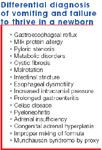Puzzler: An infant with vomiting and failure to thrive
An infant with non projectile vomiting and poor weight gain is eventually diagnosed with Hirschsprung's Disease.

Is this a case of failure to thrive?
He is a slow feeder and has been fussy; however, he was consolable and showed no respiratory distress during feeds. Intrigued, you also find that the infant weighed 6 pounds 2 ounces at birth but weighs only 7 pounds 2 ounces at admission. In the pediatrician's referral note, you see that the infant's mother was concerned about constipation one week prior to admission-however, bowel movements occurred once to three times daily, and are soft and light brown. Searching for late passage of meconium or jaundice, you review the nursery discharge papers but find no evidence of anything alarming. A newborn screen, sent on day two of life, was also normal. On review of systems, there is no fever, decrease in urine output, or sick contacts. Finally, the family history is negative for consanguinity or any heritable entities, such as pyloric stenosis or cystic fibrosis.
You begin your work-up with a CBC (complete blood count), a full chemistry panel with a liver function profile, and a urinalysis. They are normal, and you are relieved to find no acidosis or hypoproteinemia. A thyroid panel is likewise unremarkable. At this point, your findings point in the direction of reflux disease, a not too-uncommon entity among newborns. Milk protein allergy is also on your differential. You propose a trial of ranitidine and continue the infant on a soy-based formula. A stool sample is sent for occult blood testing, and it is reassuringly negative.
The next morning, you schedule an upper GI study. It shows repeated episodes of reflux extending to the upper thoracic esophagus, but not gastric outlet obstruction, anatomic abnormality, or any malrotation. You continue the H-2 blocker and increase caloric intake by switching the infant to a 24-calorie soy formula. On hospital day four, you are glad to note that the vomiting ceased and the boy has gained almost 3 ounces. Just as you are ready to write "discharge planning" on your to-do list comes the first bump on the road-a fever of 101° F (38.6° C).
Artificial intelligence improves congenital heart defect detection on prenatal ultrasounds
January 31st 2025AI-assisted software improves clinicians' detection of congenital heart defects in prenatal ultrasounds, enhancing accuracy, confidence, and speed, according to a study presented at SMFM's Annual Pregnancy Meeting.